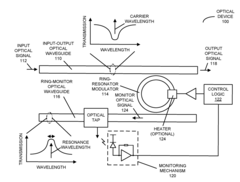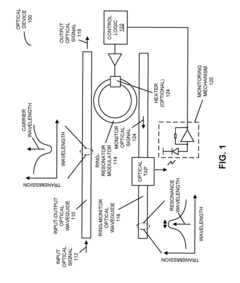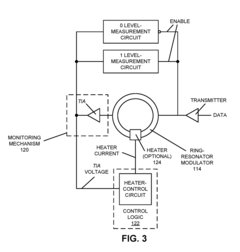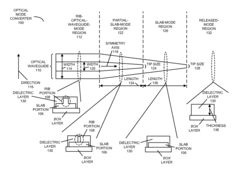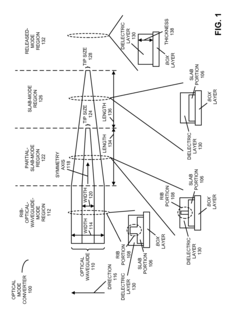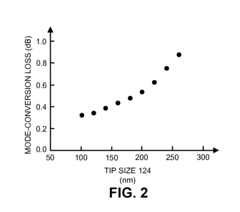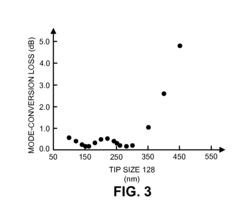Role of silicon photonics in developing drone communication networks.
JUL 17, 20259 MIN READ
Generate Your Research Report Instantly with AI Agent
Patsnap Eureka helps you evaluate technical feasibility & market potential.
Silicon Photonics Evolution
Silicon photonics has undergone a remarkable evolution since its inception in the late 1980s, playing an increasingly crucial role in various technological domains, including drone communication networks. The journey of silicon photonics began with the vision of integrating optical components with silicon-based electronic circuits, leveraging the well-established semiconductor manufacturing infrastructure.
In the early stages, researchers focused on overcoming the fundamental limitations of silicon as an optical material, particularly its indirect bandgap nature, which made it challenging to achieve efficient light emission. The breakthrough came in the mid-2000s with the development of silicon-based modulators and photodetectors, paving the way for practical silicon photonic devices.
The next phase of evolution saw significant improvements in integration density and performance. Researchers developed advanced waveguide structures, efficient coupling mechanisms, and novel designs for passive and active components. This period also witnessed the emergence of hybrid integration approaches, combining silicon with other materials like III-V semiconductors to enhance functionality.
As silicon photonics matured, it began to find applications in data centers and telecommunications, driven by the need for higher bandwidth and energy efficiency. The technology's ability to transmit data at high speeds over long distances with minimal loss made it an attractive solution for these sectors.
In recent years, silicon photonics has expanded its reach to new domains, including sensing, biomedical applications, and, notably, drone communication networks. The technology's compact size, low power consumption, and high-speed data transmission capabilities make it particularly suitable for the demanding requirements of drone communications.
The evolution of silicon photonics in the context of drone networks has focused on developing integrated transceivers capable of handling the high-bandwidth, low-latency communication needs of unmanned aerial vehicles. Researchers have worked on optimizing silicon photonic components for the specific challenges of aerial communication, such as dealing with rapid changes in signal strength and maintaining reliable links in dynamic environments.
Looking ahead, the future of silicon photonics in drone communication networks promises even greater integration and functionality. Ongoing research is exploring advanced modulation schemes, adaptive beam steering techniques, and the incorporation of artificial intelligence to enhance network performance and reliability. These developments are expected to enable more sophisticated drone swarm communications and support the growing demands of autonomous aerial systems.
In the early stages, researchers focused on overcoming the fundamental limitations of silicon as an optical material, particularly its indirect bandgap nature, which made it challenging to achieve efficient light emission. The breakthrough came in the mid-2000s with the development of silicon-based modulators and photodetectors, paving the way for practical silicon photonic devices.
The next phase of evolution saw significant improvements in integration density and performance. Researchers developed advanced waveguide structures, efficient coupling mechanisms, and novel designs for passive and active components. This period also witnessed the emergence of hybrid integration approaches, combining silicon with other materials like III-V semiconductors to enhance functionality.
As silicon photonics matured, it began to find applications in data centers and telecommunications, driven by the need for higher bandwidth and energy efficiency. The technology's ability to transmit data at high speeds over long distances with minimal loss made it an attractive solution for these sectors.
In recent years, silicon photonics has expanded its reach to new domains, including sensing, biomedical applications, and, notably, drone communication networks. The technology's compact size, low power consumption, and high-speed data transmission capabilities make it particularly suitable for the demanding requirements of drone communications.
The evolution of silicon photonics in the context of drone networks has focused on developing integrated transceivers capable of handling the high-bandwidth, low-latency communication needs of unmanned aerial vehicles. Researchers have worked on optimizing silicon photonic components for the specific challenges of aerial communication, such as dealing with rapid changes in signal strength and maintaining reliable links in dynamic environments.
Looking ahead, the future of silicon photonics in drone communication networks promises even greater integration and functionality. Ongoing research is exploring advanced modulation schemes, adaptive beam steering techniques, and the incorporation of artificial intelligence to enhance network performance and reliability. These developments are expected to enable more sophisticated drone swarm communications and support the growing demands of autonomous aerial systems.
Drone Network Market Analysis
The drone network market is experiencing rapid growth, driven by increasing applications in various sectors such as agriculture, surveillance, delivery services, and disaster management. The global drone market size was valued at $26.3 billion in 2021 and is projected to reach $55.8 billion by 2030, with a compound annual growth rate (CAGR) of 9.4% during the forecast period. Within this broader market, drone communication networks play a crucial role in enabling efficient and reliable operations.
The demand for advanced drone communication networks is primarily fueled by the need for real-time data transmission, enhanced connectivity, and improved range capabilities. As drones become more sophisticated and autonomous, the requirements for high-bandwidth, low-latency communication systems have intensified. This has led to a growing interest in silicon photonics technology as a potential solution to address these challenges.
In the commercial sector, the adoption of drone networks is particularly strong in industries such as agriculture, construction, and logistics. Precision agriculture, for instance, relies heavily on drone networks for crop monitoring, yield optimization, and resource management. The construction industry utilizes drones for site surveying, progress monitoring, and safety inspections, all of which require robust communication networks.
The defense and security sector represents another significant market for drone communication networks. Military applications demand secure, long-range, and high-bandwidth communication systems for surveillance, reconnaissance, and tactical operations. The integration of silicon photonics in drone communication networks could potentially revolutionize these applications by offering enhanced performance and reduced size, weight, and power (SWaP) requirements.
Geographically, North America currently dominates the drone network market, followed by Europe and Asia-Pacific. However, the Asia-Pacific region is expected to witness the highest growth rate in the coming years, driven by increasing investments in drone technology and supportive government initiatives in countries like China, Japan, and India.
The market landscape for drone communication networks is characterized by a mix of established aerospace and defense companies, telecommunications giants, and innovative startups. Key players are investing heavily in research and development to gain a competitive edge in this rapidly evolving market. The integration of silicon photonics technology is seen as a potential game-changer, attracting significant attention and investment from both industry incumbents and new entrants.
The demand for advanced drone communication networks is primarily fueled by the need for real-time data transmission, enhanced connectivity, and improved range capabilities. As drones become more sophisticated and autonomous, the requirements for high-bandwidth, low-latency communication systems have intensified. This has led to a growing interest in silicon photonics technology as a potential solution to address these challenges.
In the commercial sector, the adoption of drone networks is particularly strong in industries such as agriculture, construction, and logistics. Precision agriculture, for instance, relies heavily on drone networks for crop monitoring, yield optimization, and resource management. The construction industry utilizes drones for site surveying, progress monitoring, and safety inspections, all of which require robust communication networks.
The defense and security sector represents another significant market for drone communication networks. Military applications demand secure, long-range, and high-bandwidth communication systems for surveillance, reconnaissance, and tactical operations. The integration of silicon photonics in drone communication networks could potentially revolutionize these applications by offering enhanced performance and reduced size, weight, and power (SWaP) requirements.
Geographically, North America currently dominates the drone network market, followed by Europe and Asia-Pacific. However, the Asia-Pacific region is expected to witness the highest growth rate in the coming years, driven by increasing investments in drone technology and supportive government initiatives in countries like China, Japan, and India.
The market landscape for drone communication networks is characterized by a mix of established aerospace and defense companies, telecommunications giants, and innovative startups. Key players are investing heavily in research and development to gain a competitive edge in this rapidly evolving market. The integration of silicon photonics technology is seen as a potential game-changer, attracting significant attention and investment from both industry incumbents and new entrants.
Silicon Photonics Challenges
Silicon photonics, while promising for drone communication networks, faces several significant challenges that need to be addressed for widespread adoption and optimal performance. One of the primary obstacles is the integration of photonic components with existing electronic systems. The mismatch between the scale of photonic devices and electronic circuits creates difficulties in achieving seamless integration, potentially limiting the overall system efficiency.
Thermal management presents another critical challenge in silicon photonics for drone applications. The heat generated by photonic components can affect their performance and reliability, especially in the compact and mobile environment of drones. Developing effective cooling solutions without adding significant weight or complexity to the drone system is crucial for maintaining optimal communication capabilities.
The manufacturing process for silicon photonic devices also poses challenges. Achieving high-yield, cost-effective production of complex photonic circuits requires advanced fabrication techniques and precise control over material properties. This can lead to increased production costs and potential scalability issues, which may hinder widespread adoption in drone communication networks.
Power consumption is a significant concern in drone applications, where energy efficiency is paramount. While silicon photonics offers potential advantages in this area, further optimization is needed to minimize power requirements without compromising performance. This includes developing more efficient lasers, modulators, and detectors specifically tailored for drone communication needs.
Environmental factors present unique challenges for silicon photonic systems in drone networks. Exposure to varying temperatures, humidity, and vibrations can affect the stability and reliability of photonic components. Developing robust packaging and protection methods to ensure consistent performance across diverse operating conditions is essential for reliable drone communications.
The need for high-speed, low-latency data transmission in drone networks puts additional pressure on silicon photonic systems. Achieving the required data rates while maintaining signal integrity over potentially long distances and through various atmospheric conditions remains a significant technical hurdle. This challenge is compounded by the need for compact, lightweight solutions suitable for drone platforms.
Lastly, the integration of silicon photonics with other emerging technologies, such as 5G and beyond, presents both opportunities and challenges. Ensuring compatibility and seamless operation with existing and future communication standards is crucial for the long-term viability of silicon photonics in drone networks. This requires ongoing research and development to align photonic technologies with evolving communication protocols and network architectures.
Thermal management presents another critical challenge in silicon photonics for drone applications. The heat generated by photonic components can affect their performance and reliability, especially in the compact and mobile environment of drones. Developing effective cooling solutions without adding significant weight or complexity to the drone system is crucial for maintaining optimal communication capabilities.
The manufacturing process for silicon photonic devices also poses challenges. Achieving high-yield, cost-effective production of complex photonic circuits requires advanced fabrication techniques and precise control over material properties. This can lead to increased production costs and potential scalability issues, which may hinder widespread adoption in drone communication networks.
Power consumption is a significant concern in drone applications, where energy efficiency is paramount. While silicon photonics offers potential advantages in this area, further optimization is needed to minimize power requirements without compromising performance. This includes developing more efficient lasers, modulators, and detectors specifically tailored for drone communication needs.
Environmental factors present unique challenges for silicon photonic systems in drone networks. Exposure to varying temperatures, humidity, and vibrations can affect the stability and reliability of photonic components. Developing robust packaging and protection methods to ensure consistent performance across diverse operating conditions is essential for reliable drone communications.
The need for high-speed, low-latency data transmission in drone networks puts additional pressure on silicon photonic systems. Achieving the required data rates while maintaining signal integrity over potentially long distances and through various atmospheric conditions remains a significant technical hurdle. This challenge is compounded by the need for compact, lightweight solutions suitable for drone platforms.
Lastly, the integration of silicon photonics with other emerging technologies, such as 5G and beyond, presents both opportunities and challenges. Ensuring compatibility and seamless operation with existing and future communication standards is crucial for the long-term viability of silicon photonics in drone networks. This requires ongoing research and development to align photonic technologies with evolving communication protocols and network architectures.
Current Photonic Solutions
01 Integration of optical components on silicon
Silicon photonics involves integrating optical components onto silicon substrates, enabling the creation of high-performance photonic devices. This technology allows for the fabrication of optical waveguides, modulators, and detectors on a single chip, facilitating the development of compact and efficient optical communication systems.- Integrated photonic devices: Silicon photonics technology enables the integration of various optical components on a single chip. This includes waveguides, modulators, detectors, and other photonic elements, allowing for compact and efficient optical systems. The integration of these components facilitates high-speed data transmission and processing in optical communication networks and computing applications.
- Optical interconnects and data transmission: Silicon photonics is utilized in developing high-speed optical interconnects for data centers and telecommunications. These interconnects use light for data transmission, offering higher bandwidth and lower power consumption compared to traditional electronic interconnects. The technology enables efficient data transfer between chips, boards, and systems, addressing the increasing demand for faster and more energy-efficient communication.
- Photonic integrated circuits (PICs): Silicon photonics allows for the creation of complex photonic integrated circuits that combine multiple optical functions on a single chip. These PICs can include lasers, modulators, multiplexers, and photodetectors, enabling advanced functionalities such as wavelength division multiplexing and optical signal processing. The integration of these components on silicon substrates offers cost-effective and scalable solutions for various applications.
- Silicon-based light sources and modulators: Advancements in silicon photonics have led to the development of efficient light sources and modulators integrated on silicon chips. This includes the creation of silicon-based lasers, LEDs, and high-speed electro-optic modulators. These components are crucial for enabling on-chip optical communication and processing, overcoming the limitations of traditional silicon-based electronics in terms of speed and energy efficiency.
- Silicon photonics in quantum computing: Silicon photonics technology is being explored for quantum computing applications. It offers potential advantages in creating scalable quantum photonic circuits, including the integration of single-photon sources, detectors, and quantum gates on a silicon chip. This approach could lead to the development of more practical and efficient quantum computing systems, leveraging the existing silicon fabrication infrastructure.
02 Optical interconnects for data transmission
Silicon photonics enables the development of optical interconnects for high-speed data transmission. These interconnects use light to transmit data between chips or within a chip, offering higher bandwidth and lower power consumption compared to traditional electrical interconnects. This technology is crucial for addressing the increasing demand for data transfer in computing and communication systems.Expand Specific Solutions03 Photonic integrated circuits (PICs)
Silicon photonics facilitates the creation of photonic integrated circuits, which combine multiple optical functions on a single chip. These PICs can include lasers, modulators, waveguides, and detectors, enabling complex optical processing and signal manipulation. The integration of multiple components on a single chip reduces size, cost, and power consumption while improving overall system performance.Expand Specific Solutions04 Silicon-based optical sensors and detectors
Silicon photonics technology enables the development of highly sensitive optical sensors and detectors. These devices can be used for various applications, including environmental monitoring, biomedical sensing, and spectroscopy. The integration of optical sensing elements with silicon-based electronics allows for compact and cost-effective sensor solutions.Expand Specific Solutions05 Hybrid integration of III-V materials with silicon
To overcome the limitations of silicon as a light source, hybrid integration techniques are used to combine III-V materials with silicon photonics platforms. This approach allows for the integration of efficient light sources, such as lasers, with silicon-based photonic circuits, enabling the creation of fully integrated photonic systems on a single chip.Expand Specific Solutions
Key Industry Players
The silicon photonics market for drone communication networks is in its early growth stage, with significant potential for expansion. The market size is expected to grow rapidly as drone technology advances and demand for high-bandwidth, low-latency communication increases. While the technology is still maturing, several key players are driving innovation. Companies like Huawei, IBM, and GlobalFoundries are investing heavily in silicon photonics research and development. Academic institutions such as MIT, Nanyang Technological University, and Xidian University are also contributing to technological advancements. The involvement of both industry leaders and research institutions indicates a growing ecosystem and accelerating progress towards commercialization of silicon photonics in drone communication networks.
Huawei Technologies Co., Ltd.
Technical Solution: Huawei has developed advanced silicon photonics solutions for drone communication networks. Their approach integrates high-speed optical transceivers with compact, lightweight designs suitable for drone payloads. Huawei's silicon photonics technology enables data transmission rates up to 100 Gbps[1], significantly enhancing the bandwidth and range of drone communications. The company has also implemented wavelength division multiplexing (WDM) techniques, allowing multiple data streams to be transmitted simultaneously over a single optical fiber[2]. This increases the overall capacity of the drone communication network while reducing the physical footprint of the communication equipment.
Strengths: High data transmission rates, compact design, and advanced WDM capabilities. Weaknesses: Potential high cost and complexity of implementation in small-scale drone systems.
GlobalFoundries U.S., Inc.
Technical Solution: GlobalFoundries has developed a robust silicon photonics platform that can be applied to drone communication networks. Their approach focuses on providing a scalable, high-volume manufacturing solution for integrated photonics devices. GlobalFoundries' silicon photonics technology offers monolithic integration of photonic components with CMOS circuits, enabling compact and efficient communication modules suitable for drone applications. Their platform supports data rates up to 112 Gbps per channel[9], with the potential for higher speeds through wavelength division multiplexing. GlobalFoundries has also developed low-loss optical waveguides and efficient fiber coupling techniques, which are crucial for maintaining signal integrity in drone-based communication systems. The company's expertise in RF and mmWave technologies complements their silicon photonics offerings, potentially allowing for hybrid communication solutions in drone networks.
Strengths: Scalable manufacturing process, high-speed performance, and potential for integration with RF technologies. Weaknesses: May require significant investment for customization to specific drone communication requirements.
Core Photonic Innovations
In-situ ring-resonator-modulator calibration
PatentActiveUS20180259797A1
Innovation
- An optical device with a ring-resonator modulator having an adjustable resonance wavelength, monitored by a ring-monitor optical waveguide and controlled by a mechanism that adjusts the resonance wavelength based on performance metrics such as average optical power or signal swing, using techniques like thermal tuning or carrier injection to optimize performance.
Optical mode converter having multiple regions
PatentActiveUS20170045686A1
Innovation
- An optical mode converter design featuring a silicon inverse-taper structure with a rib-optical-waveguide-mode region, a partial-slab-mode region, and a slab-mode region, where the widths of the slab and rib portions decrease to a first and second minimum tip size greater than 180 nm, respectively, with a dielectric layer over the rib and slab portions, enabling smooth mode transitions compatible with standard CMOS processes.
Regulatory Framework
The regulatory framework surrounding silicon photonics in drone communication networks is a complex and evolving landscape. As this technology advances, governments and international bodies are working to establish guidelines that balance innovation with safety and security concerns.
At the national level, many countries are developing regulations specific to drone operations and communications. These often include restrictions on flight altitudes, no-fly zones, and requirements for operator licensing. For silicon photonics-enabled drone communications, regulators are particularly focused on spectrum allocation and interference prevention.
The International Telecommunication Union (ITU) plays a crucial role in coordinating global spectrum usage for drone communications. They have allocated specific frequency bands for unmanned aircraft systems, which silicon photonics-based systems must adhere to. The ITU also sets standards for electromagnetic compatibility to prevent interference with other wireless services.
Aviation authorities, such as the Federal Aviation Administration (FAA) in the United States and the European Union Aviation Safety Agency (EASA), are developing regulations for beyond visual line of sight (BVLOS) drone operations. These regulations often include requirements for reliable communication links, which silicon photonics technology can help address.
Data privacy and security regulations also impact the development of silicon photonics in drone communication networks. Laws such as the General Data Protection Regulation (GDPR) in the European Union set strict requirements for data protection, which must be considered in the design of communication systems.
Standardization bodies, including the Institute of Electrical and Electronics Engineers (IEEE) and the International Organization for Standardization (ISO), are working on technical standards for drone communications. These standards aim to ensure interoperability and reliability of silicon photonics-based systems across different manufacturers and applications.
Export control regulations, such as the Wassenaar Arrangement, may apply to certain silicon photonics technologies used in drone communications. These regulations aim to prevent the proliferation of dual-use technologies that could have military applications.
As the technology continues to evolve, regulators face the challenge of keeping pace with innovation while ensuring public safety and national security. This dynamic regulatory environment requires ongoing collaboration between industry stakeholders, researchers, and policymakers to develop appropriate frameworks for the deployment of silicon photonics in drone communication networks.
At the national level, many countries are developing regulations specific to drone operations and communications. These often include restrictions on flight altitudes, no-fly zones, and requirements for operator licensing. For silicon photonics-enabled drone communications, regulators are particularly focused on spectrum allocation and interference prevention.
The International Telecommunication Union (ITU) plays a crucial role in coordinating global spectrum usage for drone communications. They have allocated specific frequency bands for unmanned aircraft systems, which silicon photonics-based systems must adhere to. The ITU also sets standards for electromagnetic compatibility to prevent interference with other wireless services.
Aviation authorities, such as the Federal Aviation Administration (FAA) in the United States and the European Union Aviation Safety Agency (EASA), are developing regulations for beyond visual line of sight (BVLOS) drone operations. These regulations often include requirements for reliable communication links, which silicon photonics technology can help address.
Data privacy and security regulations also impact the development of silicon photonics in drone communication networks. Laws such as the General Data Protection Regulation (GDPR) in the European Union set strict requirements for data protection, which must be considered in the design of communication systems.
Standardization bodies, including the Institute of Electrical and Electronics Engineers (IEEE) and the International Organization for Standardization (ISO), are working on technical standards for drone communications. These standards aim to ensure interoperability and reliability of silicon photonics-based systems across different manufacturers and applications.
Export control regulations, such as the Wassenaar Arrangement, may apply to certain silicon photonics technologies used in drone communications. These regulations aim to prevent the proliferation of dual-use technologies that could have military applications.
As the technology continues to evolve, regulators face the challenge of keeping pace with innovation while ensuring public safety and national security. This dynamic regulatory environment requires ongoing collaboration between industry stakeholders, researchers, and policymakers to develop appropriate frameworks for the deployment of silicon photonics in drone communication networks.
Environmental Impact
The integration of silicon photonics in drone communication networks presents both opportunities and challenges from an environmental perspective. While this technology offers potential benefits in terms of energy efficiency and reduced material usage, it also raises concerns about electronic waste and manufacturing processes.
Silicon photonics can significantly improve the energy efficiency of drone communication systems. By utilizing light for data transmission, these systems consume less power compared to traditional electronic counterparts. This reduced energy consumption translates to longer flight times for drones and decreased overall energy requirements for network infrastructure. Consequently, the carbon footprint associated with drone operations and network maintenance could be substantially lowered.
The miniaturization capabilities of silicon photonics also contribute to environmental benefits. Smaller, lighter components mean drones can be designed with reduced weight and size, further enhancing energy efficiency during flight. Additionally, the compact nature of silicon photonic devices leads to less material usage in manufacturing, potentially reducing the environmental impact of production processes.
However, the environmental impact of silicon photonics in drone communication networks is not without concerns. The production of silicon photonic components involves complex manufacturing processes that may require specialized materials and energy-intensive fabrication techniques. These processes could potentially lead to increased resource consumption and emissions if not managed properly.
The issue of electronic waste (e-waste) is another environmental consideration. As drone communication networks evolve and adopt silicon photonic technologies, older equipment may become obsolete more quickly. This rapid turnover of technology could contribute to the growing problem of e-waste if proper recycling and disposal methods are not implemented.
Electromagnetic radiation is an additional environmental factor to consider. While silicon photonic systems generally operate at lower power levels than traditional radio frequency communications, the proliferation of drone networks may still raise concerns about potential impacts on wildlife and ecosystems. Further research is needed to fully understand the long-term effects of these systems on the environment.
Despite these challenges, the potential for silicon photonics to enable more efficient and sustainable drone communication networks is significant. As the technology matures, it is crucial to focus on developing environmentally friendly manufacturing processes, implementing effective recycling programs, and conducting thorough environmental impact assessments. By addressing these concerns proactively, the integration of silicon photonics in drone communication networks can contribute to more sustainable and environmentally responsible technological advancements.
Silicon photonics can significantly improve the energy efficiency of drone communication systems. By utilizing light for data transmission, these systems consume less power compared to traditional electronic counterparts. This reduced energy consumption translates to longer flight times for drones and decreased overall energy requirements for network infrastructure. Consequently, the carbon footprint associated with drone operations and network maintenance could be substantially lowered.
The miniaturization capabilities of silicon photonics also contribute to environmental benefits. Smaller, lighter components mean drones can be designed with reduced weight and size, further enhancing energy efficiency during flight. Additionally, the compact nature of silicon photonic devices leads to less material usage in manufacturing, potentially reducing the environmental impact of production processes.
However, the environmental impact of silicon photonics in drone communication networks is not without concerns. The production of silicon photonic components involves complex manufacturing processes that may require specialized materials and energy-intensive fabrication techniques. These processes could potentially lead to increased resource consumption and emissions if not managed properly.
The issue of electronic waste (e-waste) is another environmental consideration. As drone communication networks evolve and adopt silicon photonic technologies, older equipment may become obsolete more quickly. This rapid turnover of technology could contribute to the growing problem of e-waste if proper recycling and disposal methods are not implemented.
Electromagnetic radiation is an additional environmental factor to consider. While silicon photonic systems generally operate at lower power levels than traditional radio frequency communications, the proliferation of drone networks may still raise concerns about potential impacts on wildlife and ecosystems. Further research is needed to fully understand the long-term effects of these systems on the environment.
Despite these challenges, the potential for silicon photonics to enable more efficient and sustainable drone communication networks is significant. As the technology matures, it is crucial to focus on developing environmentally friendly manufacturing processes, implementing effective recycling programs, and conducting thorough environmental impact assessments. By addressing these concerns proactively, the integration of silicon photonics in drone communication networks can contribute to more sustainable and environmentally responsible technological advancements.
Unlock deeper insights with Patsnap Eureka Quick Research — get a full tech report to explore trends and direct your research. Try now!
Generate Your Research Report Instantly with AI Agent
Supercharge your innovation with Patsnap Eureka AI Agent Platform!
